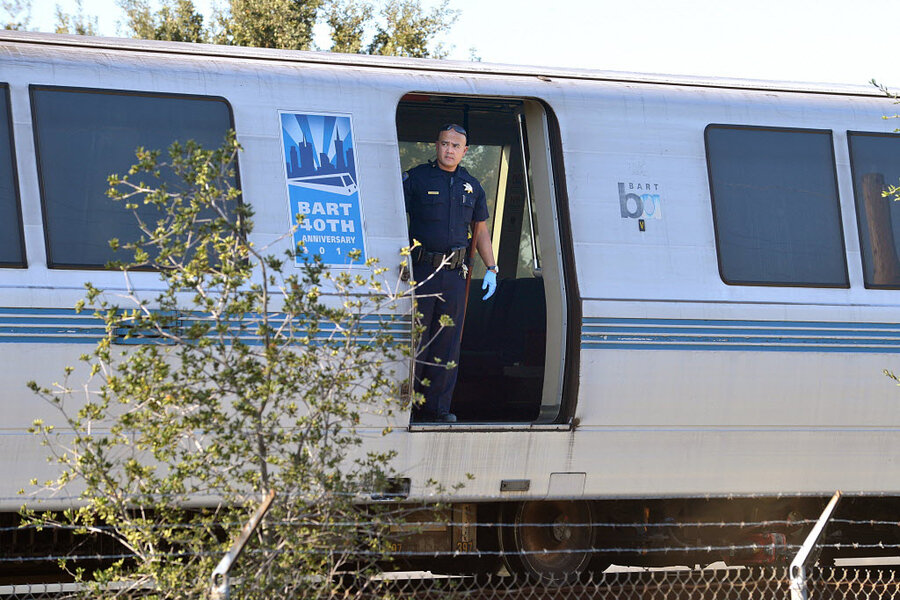Despite strike, two BART workers killed during routine maintenance trip
Loading...
| Oakland, Calif.
Despite a labor strike keeping trains out of service, two workers inspecting the tracks of a San Francisco Bay Area transit system were hit and killed by a train returning from a routine maintenance trip, officials said.
The four-car train with several people aboard was being run in automatic mode under computer control at the time of the accident, said Paul Oversier, assistant general manager of the Bay Area Rapid Transit System, which was in its second full day of a work stoppage and was moving trains only for maintenance.
At a news conference Saturday, Oversier would not say who had been the train operator. In an earlier statement, BART said only that the person was an experienced operator.
One system employee and one contractor were killed in the accident in the East Bay city of Walnut Creek shortly before 2 p.m. The train had been at a yard where workers had been cleaning off graffiti, BART officials said.
"This is a tragic day in BART's history," the system's general manager, Grace Crunican, said. "The entire BART family is grieving."
Officials from the unions representing BART's train operators and some of the system's other workers have warned of the danger that could come with allowing managers to operate trains as BART had planned to do in case of a strike. The unions have been on strike since Friday.
One of the unions on strike, Amalgamated Transit Union 1555, announced that its 900 workers would not be picketing on Sunday out of respect for the victims and their families.
Also Saturday, ATU local president Antonette Bryant said she was taking a final contract offer from BART before members for a vote, but expects it will be rejected.
"It's our hope we can get it to members this week," Bryant told The Associated Press in a telephone interview. She said she expects the vote to be "a resounding no."
Bryant later issued a statement, saying Saturday's accident was a "terrible human tragedy."
The two workers killed were inspecting a reported dip in the track.
Both had extensive experience.
"They understand the railroad, they understand how to work around moving trains," Oversier said. "They were doing today what they have done 100 if not 1000 other times in their career."
The procedures for such maintenance require one employee to inspect the track and the other to serve as a lookout for oncoming traffic, BART officials said. They did not immediately say whether that procedure had been followed.
The victim's names and ages were not immediately released.
Oversier said the worker who was killed was a member of the American Federation of State, County and Municipal Employees.
BART officials wouldn't address questions on the union's warnings about train safety during a walkout.
"The labor issues are not in the forefront of our mind," Oversier said. "We've just lost two people in the BART family."
The National Transportation Safety Board announced late Saturday that it would take over the investigation with assistance from BART and the California Public Utilities Commission.
The deaths were the first of a BART employee in five years.
In October 2008, about one stop down on the same line, 44-year-old BART employee James Strickland was hit from behind while inspecting the tracks. Trains in both directions were sharing the same stretch of track at the time because of maintenance and Strickland had apparently been unaware.
Before Saturday's accident, union leaders spent much of the day attempting to convince the riders who make 400,000 daily trips on the system that workers' demands are not unreasonable amid increasing hostility in social media and other outlets.
Officials said there was general agreement on some economic issues, but the two sides came to an impasse over work rules, including the length of the work day and when overtime pay kicks in, the union said.
Weekend BART use is light compared with the workweek, and frustrated commuters said they hoped an agreement could be quickly reached before Monday's heavy commute.
The system carries its ridership through tunnels under the bay and into the region's urban core of San Francisco from four surrounding counties, relieving what would otherwise be congested bridges.
Associated Press writer Andrew Dalton contributed to this report from Los Angeles. Cone reported from Fresno.







